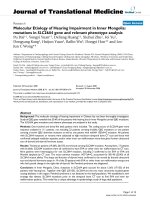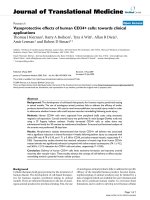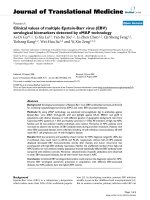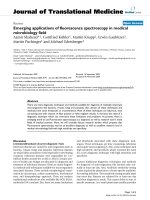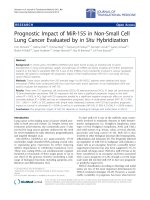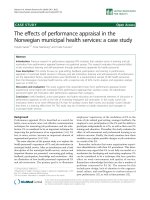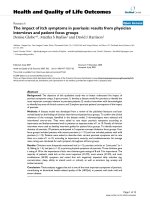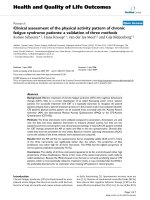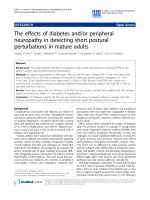báo cáo hóa học:" Clinical effects of Garcinia kola in knee osteoarthritis" doc
Bạn đang xem bản rút gọn của tài liệu. Xem và tải ngay bản đầy đủ của tài liệu tại đây (354.78 KB, 10 trang )
BioMed Central
Page 1 of 10
(page number not for citation purposes)
Journal of Orthopaedic Surgery and
Research
Open Access
Research article
Clinical effects of Garcinia kola in knee osteoarthritis
Olayinka O Adegbehingbe*
1
, Saburi A Adesanya
2
, Thomas O Idowu
3
,
Oluwakemi C Okimi
4
, Oyesiku A Oyelami
5
and Ezekiel O Iwalewa
6
Address:
1
Department of Orthopaedic Surgery and Traumatology, Faculty of Clinical Sciences, Obafemi Awolowo University, Ile-Ife, Nigeria,
2
Professor of Pharmacognosy, Department of Pharmacognosy, Faculty of Pharmacy, Obafemi Awolowo University, Ile-Ife, Nigeria,
3
Department
of Pharmaceutical Chemistry, Faculty of Pharmacy, Obafemi Awolowo University, Ile-Ife, Nigeria,
4
Department of Nursing Sciences, Faculty of
Basic Sciences, Obafemi Awolowo University, Ile-Ife, Nigeria,
5
Professor of Pediatrics and Child Health, Department of Pediatrics and Child
Health, Faculty of Clinical Sciences, Obafemi Awolowo University, Ile-Ife, Nigeria and
6
Department of Pharmacology, Faculty of Pharmacy,
Obafemi Awolowo University, Ile-Ife, Nigeria
Email: Olayinka O Adegbehingbe* - ; Saburi A Adesanya - ;
Thomas O Idowu - ; Oluwakemi C Okimi - ; Oyesiku A Oyelami - ;
Ezekiel O Iwalewa -
* Corresponding author
Abstract
Objectives: Over the past years, there has been a growing number of knee osteoarthritis (KOA)
patients who are not willing to comply with long-term non-steroidal anti-inflammatory drugs
(NSAID) treatment and wish to use herbal anti- rheumatic medicine. This study assessed the clinical
effects of Garcinia kola (GK) in KOA patients.
Patients and methods: Prospective randomized, placebo controlled, double blind, clinical trial
approved by the institutional medical ethics review board and written informed consent obtained
from each patient. All KOA patients presenting at the Obafemi Awolowo University Teaching
Hospital complex were recruited into the study. The patients were grouped into four (A = Placebo,
B = Naproxen, C = Garcinia kola, D = Celebrex). The drugs and placebo were given twice a day
per oral route. Each dose consisted of 200 mg of G. kola, Naproxen (500 mg), Celebrex (200 mg)
and Ascorbic acid (100 mg). The primary outcome measure over six weeks study period was the
change in mean WOMAC pain visual analogue scales (VAS). Secondary outcome measures included
the mean change in joint stiffness and physical function (mobility/walking).
Results: 143 patients were recruited, 84 (58.7%, males – 24, females – 60) satisfied the selection
criteria and completed the study. The effect of knee osteoarthritis bilateralism among the subjects
was not significant on their outcome (p > 0.05). The change in the mean WOMAC pain VAS after
six weeks of G. kola was significantly reduced compared to the placebo (p < 0.001). Multiple
comparisons of the mean VAS pain change of G. kola group was not lowered significantly against
the naproxen and celebrex groups (p > 0.05). The onset of G. kola symptomatic pain relief was
faster than the placebo (p < 0.001). However, it was slower than the active comparators (p > 0.05).
The duration of therapeutic effect of Garcinia kola was longer than the placebo (p > 0.001). G. kola
period of effect was less than naproxen and celebrex (p < 0.001). G. kola subjects had improved
mean change mobility/walking after six weeks better than the control group(p < 0.001). The mean
change in mobility of the G. kola group when compared to the active comparators was not
significantly better (p < 0.05). The mean change of knee joint stiffness (p < 0.001) and the change
Published: 30 July 2008
Journal of Orthopaedic Surgery and Research 2008, 3:34 doi:10.1186/1749-799X-3-34
Received: 21 February 2007
Accepted: 30 July 2008
This article is available from: />© 2008 Adegbehingbe et al; licensee BioMed Central Ltd.
This is an Open Access article distributed under the terms of the Creative Commons Attribution License ( />),
which permits unrestricted use, distribution, and reproduction in any medium, provided the original work is properly cited.
Journal of Orthopaedic Surgery and Research 2008, 3:34 />Page 2 of 10
(page number not for citation purposes)
of mean WOMAC score (p < 0.001) were improved on Garcinia kola as compared to the placebo.
The mid term outcome of eleven Garcinia kola subjects after cessation of use had a mean pain relief
period of 17.27 +/- 5.15 days (range: 9–26 days). There was no significant cardiovascular, renal or
drug induced adverse reaction to Garcinia kola.
Conclusion: Garcinia kola appeared to have clinically significant analgesic/anti-inflammatory effects
in knee osteoarthritis patients. Garcinia kola is a potential osteoarthritis disease activity modifier
with good mid term outcome. Further studies are required for standardization of dosages and to
determine long-term effects.
Background
Osteoarthritis is the most common form of joint disease,
affecting the knee more than other joints [1]. Several fac-
tors play a role in osteoarthritis risk; these include age,
gender, genetics, behavioral influences and ethnicity [2].
Trauma is a recognized predisposing factor to develop-
ment of osteoarthritis of the knee (KOA) associated with
raised intra osseous pressure and death of the chondro-
cytes. Osteoarthritis of the knees reduces the ability to
avoid obstacles and supporting epidemiologic studies
have found osteoarthritis to be a risk factor for falls [3].
The pain associated with osteoarthritis of the knees
increased the propensity to trip on an obstacle and under-
scores the importance of treating pain associated with
osteoarthritis [3].
As the population ages or the disease worsens, knee oste-
oarthritis is associated with incapacity and a deteriorating
quality of life owing to increased pain, loss of mobility,
and the consequent loss of functional independence [4].
There is general increase in life expectancy with increasing
involvement of the younger age group in foot ball, road
traffic injuries, political/communal wars and disaster. It
means that increasing numbers of people will present
with reduced quality of life associated knee osteoarthritis.
As a result, osteoarthritis is often treated by medical or sur-
gical intervention. Pain relief is therefore a fundamental
aspect in dealing with this illness.
In patients in whom pharmacological treatment is ineffec-
tive, who are not candidates for surgery (or who reject it);
other pain and predisposing factors management proce-
dures should be considered [5]. Drug therapy of osteoar-
thritis is empirical and largely directed towards providing
symptomatic relief, primarily by the use of analgesics and
non-steroidal anti-inflammatory drugs (NSAIDs). Over
the past years, there are a growing number of younger age
group patients with KOA patients who are not willing to
comply with long term NSAIDs treatment and who wish
to use more naturally occurring ant rheumatic medicine.
Garcinia kola Heckel of the family Guttiferaceae [6] is
called Kola bitter, Bitter Kola, False or Male Kola. The
Nigerian names are Adu, Ugolu in Ibo language; Orogbo
in Yoruba; and Akan in Tweapia language. The constitu-
ents include- Flavinoids (bioflavonoid), xanthenes and
benzophenones. It has shown anti-inflammatory, ant par-
asitic, antimicrobial and antiviral properties [[7-12], and
[13]].
The pharmacodynamic mechanism of Garcinia kola action is
anchored on Kolaviron (KV) [[14-17], and [18]]. Garcinia
kola acts by restoring and maintaining the balance of fatty
acids in osteoarthritis. It causes balanced inhibition of
metabolism in the cyclo oxgenase pathway (COX-1 and
COX-2). It inhibits amino acid metabolism by the 5-
lipoxygenase (5-LOX) enzymes. Therefore the normal
physiologic organ functions are maintained. The inhibi-
tion of 5-LOX result into reduction in the production of
leukotrienes (LTB4), an agent that do enhance white
blood cell chemo taxis and the subsequent release of his-
tamines, reactive oxygen species and pro-inflammatory
cytokines. Garcinia kola has a strong antioxidant effect
which limits the oxidative conversion of amino acid by
reactive oxygen species to other damaging fatty acid prod-
ucts [19]. Kolaviron exerts a hypocholesterolaemic effect
which illustrate the anti-atherogenic property of G. kola
[20]. The excretion has neither organ nor behavioral
abnormalities. Blood electrolytes were unchanged and
liver enzymes and markers of renal function were all
within normal limits [14,16].
Safety of the food effects
Garcinia kola is safe taken with or without other foods.
Taking it an hour before or after meals may help to
increase the absorption of the key ingredients. Food does
not affect the metabolism of G. kola and may buffer effects
of mild indigestion [17]. Garcinia kola is primarily carried
bound to albumin in the blood and only a minor amount
is metabolized by hepatic metabolism [18]. Kolaviron
does not affect phase 1 drug metabolizing enzymes [16]
but induce phase 2 enzymes [21]. It may be classified as a
bifunctional inducer according to the classification of
Greenwald et al 1995 [22].
Drug interactions of Kolaviron have been shown to be
hepatoprotective [[7,10,21,23,24], and [25]]. It does not
appear to have a pronounced effect on drug metabolizing
Journal of Orthopaedic Surgery and Research 2008, 3:34 />Page 3 of 10
(page number not for citation purposes)
enzymes [21] and no known interactions with orthodox
medications [26]. The tablet properties could be control-
led to obtain optimal release of the bioactive compounds
[27].
Although surgery can relieve the pain of KOA and restore
function, not all patients are candidates for surgery, and
many want to avoid or delay it if possible. Therefore, alter-
native treatments are important [28] which could include
G. kola that have not been evaluated for knee osteoarthri-
tis. To date, there is no clinical documentation of the
effect of G. kola on the knee osteoarthritis through a
Medline search and locally available literatures. The
research hypothesis was that G. kola have a positive effect
on knee osteoarthritis as depicted in Yoruba folk songs.
The objective of the study was to evaluate the clinical
effects of G kola on knee osteoarthritis pain, stiffness and
function. The effects of G. kola in KOA is been investigated
in Nigerians through a multidisciplinary research study
group based at the Obafemi Awolowo University, Ile-Ife,
Osun State; Nigeria.
Methods
Inclusion criteria
Men and women between the ages of 18 and 80 years were
enlisted if they had knee trauma or overuse of the knees
prior to the onset of symptomatic osteoarthritis. Only
uncomplicated hypertensive patients solely on Nifedipine
were included. Within the routine clinical practice, many
of our confirmed KOA patients do present with hyperten-
sive heart disease on multiple therapies. Basically our
research center is in resource constrained country where
high technology laboratory support needed to identify
specific adverse drug interactions that could be associated
with multiple anti hypertensive medications is not availa-
ble. It was due to this peculiar limitation and the need to
enhance clarity of interpretation of subject's clinical fea-
tures, study drug's efficacy and safety assessment within
available international standard facilities that necessitated
the inclusion of patients with uncomplicated hyperten-
sive solely on Nifedipine.
Patient's diets were not altered from their pre study
period. The other inclusion criteria in the study were –
osteoarthritis of the knee verified according to the clinical,
laboratory, radiographic criteria of the American College
of Rheumatology (ACR) and resting visual analog scale
pain intensity in the target knee > 45 mm.
Exclusion criteria
Patients with known allergic reactions (to Garcinia kola,
celebrex and naproxen); Kidney failure (blood creatinine
> 84 umol/L); abnormal liver function (SGOT > 35 U/L or
SGPT > 35 U/L or GGT > 50 U/L); gastrointestinal ulcers
(bleeding or discolored stool during the past 8 weeks);
malignant diseases; systemic therapy with corticosteroids
during the past 8 weeks; surgery of the test joint during the
past 8 weeks; inflammatory joint diseases(ESR > 40 mm/
h);chronic heart failure (NYHA grade III or IV); Chronic
obstructive airway disease requiring prophylactic medica-
tion and participation on a clinical trial during the past 4
weeks. Patients with absolute indication for surgery and
knee instability were excluded. Subjects with high levels of
clinical disability (> 34 on the WOMAC scale) were
excluded as it was unlikely that they could perform the
experimental protocol consistently. Also the knee requir-
ing no weight bearing and who had intra-articular injec-
tions into the study joint within 3 months prior to first
visit were excluded. No herbal or allopathic treatment,
which could influence the outcome of the study, was per-
mitted during the course of the study. Crossing over of
patients from one subgroup to another was excluded
through surveillance.
Settings
Subjects were recruited into the study between February
20
th
, 2004 and August 19
th
, 2006 at the orthopedics and
general outpatient's clinics of the Obafemi Awolowo Uni-
versity Teaching Hospital Complex, Ile-Ife (OAUTHC);
Nigeria.
Study medication and blinding
At the beginning of the study, no commercial preparation
of Garcinia kola was available. G. kola seeds were obtained
from a market in Ile-Ife, authenticated by Mr. A.T.
Oladele, the herbarium, Department of Pharmacognosy,
Obafemi Awolowo University.
G. kola 200 mg was given twice orally per day for six
weeks. Active comparators were Naproxen 500 mg tablets
twice daily, and Celebrex 200 mg twice daily were given
orally. Placebo study medication was ascorbic acid, 100
mg tablet given twice daily. The patient in each group was
given identical study medication of the same physical
appearance aimed at eliminating psychological effects on
the subjects. The subjects have not been previously
exposed to research drug medications.
All study medications were prepared by a 10 years post-
qualified nursing staff and administered to each patient
by a senior registrar in orthopedic surgery. A family med-
icine physician of five year post fellowship qualification
acted as a masked clinical outcome evaluator. The volun-
tary nursing staff, the senior registrar and masked evalua-
tor were not part of the study group. The Nifedipine for
hypertensive were supplied to patients from the teaching
hospital pharmacy shop to ensure uniformity of quality
control. A consultant radiologist with a neutral role status
in the study screened the plain X-ray of patients and con-
firmed radiological features of knee osteoarthritis.
Journal of Orthopaedic Surgery and Research 2008, 3:34 />Page 4 of 10
(page number not for citation purposes)
Study design
It was a randomized, double-blind, placebo-controlled,
parallel-group study trial of the clinical effects of G. kola in
knee osteoarthritis. The research medication dose asses-
sor, clinical assessors, subjects and orthopedic surgeons
were blinded to the treatment group for the six weeks of
study. The G. kola subgroup was followed up for the mid-
term evaluation of therapeutic effect after the intake was
discontinued.
The study was approved by the institutional medical eth-
ics review board and was carried out in accordance with
the ethical principles of the Declaration of Helsinki. A
written informed consent was obtained from each patient
that fulfilled the inclusion criteria before randomization.
Study randomization
To determine the presence of KOA, detailed history was
obtained and clinical examination performed. Adults
were classified as having clinical knee OA by using the cri-
teria determined by the American College of Rheumatol-
ogy (ACR) [29].
Randomization occurred in blocks of four within each
stratum, using computer generated random numbers
(Excel 5.0). The patients were grouped into four (A = pla-
cebo, B = naproxen, C = Garcinia kola, D = celebrex). Both
assessors and patients were blind to the allocation and not
informed about the block size until after completion of
the study. Subjects were treated for six weeks and each of
them had weekly follow-up visits until the time of study
withdrawal. Study medications were taken in the morning
and at noon, half an hour before meal times. No addi-
tional analgesics, NSAIDs or systemic corticosteroids were
allowed during the study phases.
Objectives
At all visits, the patients completed WOMAC index to
assess pain, stiffness, and physical function. The primary
efficacy end point was the mean change from baseline in
the WOMAC pain subscale VAS at six weeks. Secondary
outcome measures included the stiffness and physical
function.
Clinical assessments
Patients were assessed by consultant orthopedic surgeon
at days -7, 0, 7, 14, 21, 28, 35 and 42.
The initial assessment (day -7) comprised of medical his-
tory, examination and WOMAC-VAS index. The "most
painful knee joint" refer to the side of knee joint with the
highest VAS pain score when a subject is having bilateral
KOA. In bilateral knee OA, the side of the knee joint with
the highest VAS pain score was the primary focus of meas-
urement for future assessment in the study. Blood and
urine samples were taken for standard laboratory tests.
The onset of therapeutic effect of the study medication as
used in this study was the mean time (minutes) recorded
for the onset of KOA symptomatic reliefs. The duration of
therapeutic effect of the study medication was the mean
time (minutes) recorded for the return of KOA symptoms
after a relief following study medication intake.
The radio diagnostic criterion of Kellgren and Lawrence
[30]scheme was used for the knee osteoarthritis severity
assessment. All patients underwent radiographic analysis
of both knee joint using Kellgren-Lawrence less or equal
to grade 2 as case definition.
The level of clinical disability was quantified by using the
Western Ontario and McMaster University Osteoarthritis
(WOMAC) index [30]. Disability was assessed using the
physical function section of WOMAC, which contains 17
questions relating to functional disability, scored from 0
to 4 by the subject.
At the second study visits (day 0), laboratory findings were
compared with exclusion criteria and diary entries were
checked. Patients who met all study criteria filled in the
WOMAC questionnaire (baseline), received study medi-
cation and thereby entered the intent to treat population.
At the study visits on days 7,14,28,35, and 42, patients filled
in WOMAC questionnaires, and compliance was checked
by diary entries and study medication. Adverse events
were recorded by checking diary entries as well as by direct
questioning of the patients.
At the study visit on day 42, blood and urine samples were
taken. The masked clinical outcome evaluator and con-
sultant orthopedic surgeon independently recorded their
final overall assessment of the change of disease activity
by the study medication on 100 mm visual analogue
scales (VAS). Direct inquiry and visual inspection of the
returned sachets container were used for monitoring com-
pliance. The osteoarthritis protocol instrument used for
the study has a section on the disease symptom/symptom
description. It evaluates each subject from the day 0 to the
end of study at six weeks. The subjective response of the
patients to the questions on walking distance was distinct.
They were asked if the distance used to cover by walking
has improved, or there is no change, or it deteriorated at
the end of the study compared to the day 0.
Safety
The subjects who had received at least a dose of the
research medication s were assessed for their safety. Toler-
ability evaluations consisted of determining clinical labo-
ratory test abnormalities such as hepatic
(aminotransferase activities) and renal (serum creatinine)
Journal of Orthopaedic Surgery and Research 2008, 3:34 />Page 5 of 10
(page number not for citation purposes)
function, adverse events, and physical examinations.
Adverse events reported by the patient or observed by the
investigator during clinical evaluation were recorded. In
addition, patients were questioned at each visit regarding
the occurrence of adverse events using a nonspecific ques-
tion. Investigators rated the intensity of adverse events
and their subjective assessment of the relationship to
study medication while blinded to the treatment group.
Statistical analyses
All analyses were performed on the intention to treat
cohort, defined as all patients who took at least a dose of
study medications. Data were analyzed by using Statistic
Package for Social Sciences (SPSS) version 11.0 for win-
dows. The comparability of patients in the four treatment
groups was determined from the demographic data and
baseline haemodynamic values. The change in the mean
of the group and mean time of study medications thera-
peutic duration were evaluated using 2-way ANOVA with
Post Hoc comparison test. The confidence interval (CI)
was at 95% and the P-value was considered significant at
p ≤ 0.05.
Study limitations
Limited numbers of knee osteoarthritis patients were
available for the study. Lack of research grants to provide
study medications and laboratory investigations free for
long term and to include larger groups of would be sub-
jects at multiple centers in Nigeria.
Results
Demographic characteristics
A total of 143 patients who had post traumatic knee oste-
oarthritis (unilateral = 94, bilateral = 98) on 192 limbs
were recruited. Eighty-four patients (58.7%) with KOA in
121 limbs satisfied the selection criteria. All the patients
who received at least a dose of the research drugs had ade-
quate documentation of their data in each subgroup and
were used for analysis. There were 24 males (28.6%) and
60 females (71.4%) with M: F: 1:2.5. The proportion of
bilateral knees involvement is shown in Table 1 which
compared patients in the four treatment groups. The effect
of knee osteoarthritis bilateralism among the subjects was
not significant (p > 0.913). The WOMAC score at day 0
was not significantly different among the four study
groups (p > 0.05). A clinical photographs of typical Gar-
cinia kola is illustrated in Figure 1. The major sources of
trauma were Road Traffic Accident 46(54.8%), Sports
injury 19(22.6%), Fall from height 18 (21.4%) and pro-
longed over use from driving long distance for over 25
years, 1(1.2%). Knee osteoarthritis in young adults was
common after sporting knee injury and fall from height.
The women often were those carried as passenger on
motor cycle before they sustained injury. The mean dura-
tion of trauma before the onset of symptomatic knee oste-
oarthritis for males was 17.4 years +/- 7.3 and females
14.2 years +/- 8.6. There was 100% compliance rate in the
control and celebrex groups. A patient (4.76%) in the
naproxen group was unable to come to the hospital for
the last two days evaluation due to diarrhea. He was traced
home for evaluation and discovered the medication was
taken. Two patients in the Garcinia kola group stopped
after completion of 39 and 40 days on the medication. It
was due to light headedness and palpitation in each of the
patients. Both patients were hypertensive before the com-
mencement of the study. They were lost during the mid
term follow up period of the study. The data from the
patients were accepted for analysis after completion of
92.8% and 95.2% of the six weeks study period.
Clinical outcome
Analysis was restricted to eighty-four patients with ade-
quate allocation concealment. All the patients that
received at least a dose of the study medications had ade-
quate documentation of their data in each subgroup. The
change in the mean WOMAC pain VAS after six weeks of
G. kola was significantly reduced compared to the placebo
(p < 0.001, CI:-2.01_-1.15, R
2
= 0.8). Multiple compari-
sons of the mean of pain change in the G. kola group was
not lowered significantly against the naproxen and cele-
brex groups (p > 0.05, CI:-0.56–0.85). There was no statis-
tically significance between the change of mean VAS pain
reduction of the G. kola, naproxen and celebrex groups.
The mean time (minutes) of onset of symptomatic pain
relief were 61.4 +/- 11.3(range: 39.0–77.2); 69.1 +/- 13.1
(range:43.2–86.3) and 55.8 +/- 8.9 (range:37.1–67.0) for
the naproxen,G. kola and celebrex subgroup respec-
tively(p > 0.05). The onset of G. kola symptomatic pain
relief was faster than the placebo (p < 0.001, CI: 10.0–
19.9, R
2
= 0.87). However, G. kola onset of action
appeared to be slower than the active comparators (p >
0.05, CI:-2.4- 9.3) as shown in Figure 2.
Garcinia kola seeds of various sizesFigure 1
Garcinia kola seeds of various sizes.
Journal of Orthopaedic Surgery and Research 2008, 3:34 />Page 6 of 10
(page number not for citation purposes)
The mean (minutes) duration of therapeutic effect of
study medications were 527.28 +/- 60.01 (range: 418.0–
602.0), 454.09 +/- 55.49 (range: 428.8–479.3) and 563.5
+/- 38.21 (range: 546.08–580.87) for the naproxen, G.
kola and celebrex subgroup respectively. The 2-way
ANOVA with post hoc comparison of the mean duration
of G. kola therapeutic action showed it was less than that
of naproxen (p < 0.002, CI : -41.5_ -7.3) and celebrex (p
< 0.001, CI: -53.6_ -19.3, R
2
= 0.9). This is illustrated in
Figure 3.
The duration of therapeutic effect of Garcinia kola was
longer than the placebo (p < 0.001, CI: 110.2–146.8). G.
kola period of effect was less than naproxen and celebrex
(p < 0.001, CI:-54.6_-18.1, R
2
= 0.972). G. kola subjects
had improved functional mean change mobility/walking
after six weeks better than the control group(p < 0.001,
CI:0.3–0.5, R
2
= 0.8). The mean change in mobility of the
G. kola group when compared to the active comparators
was not significantly better (p < 0.05, CI:-0.15–0.15).
After six weeks of study, the Garcinia kola subjects had sig-
nificant improvement in the mean change of knee joint
stiffness (p < 0.001, CI:-2.5_-1.6, R
2
= 0.90) and a change
in mean WOMAC score (p < 0.001, CI:-26.8_-22.2, R
2
=
0.97) when compared to the placebo. Patients on G. kola
reported increased walking distance 80.9 %(p < 0.001),
joint stiffness relaxation, 95.2 %(p < 0.001), and
improved physical function 76.2 %,(p < 0.001) compared
to the placebo.
After cessation of G. kola use, eight (38.1%) patients were
lost to follow up at clinic due to farming/trading activities
which took them out of the study environment. The knee
joint pain relief reported by eleven (52.4%) patients that
were seen at clinic lasted for a mean period of 17.3 +/- 5.2
days (range: 9.0–26.0). There was no deterioration of the
disease symptoms. The two (9.52%) hypertensive subjects
(a female senior lecturer and a male principal nursing
staff) who had an episode of dizziness and light headed-
ness were excluded from the mid term follow up report.
Table 1: Baseline demographic and clinical characteristics of all randomized patients.
Demographic
characteristics
TRT GR A TRT GR B TRT GR C TRT GR D
Mean age(SD) 53.2(6.0) 51.0(7.3) 54.1(5.8) 52.5(7.1)
Age range(yr) 36–61 34–59 34–60 35–62
Sex
Female 14 15 15 16
Male 7 6 6 5
Race (%Black) 100.0 100.0 100.0 100.0
Ethnic origin(% Yoruba) 100.0 100.0 100.0 100.0
Religion(%Christianity) 80.9 76.2 90.4 80.9
Knee most affected
Right 8 7 8 6
Left 6 6 4 8
Bilateral 7 8 9 7
Clinical
characteristics
KOA mean aduration(yr) 9.2(7.5) 11.1(8.0) 9.9(10.6) 8.8(9.3)
Hypertension mean duration (yr) 7.0(5.6) 5.8(6.7) 6.1(5.3) 6.5(5.8)
N = 5 N = 6 N = 6 N = 5
Mean SBP(mm Hg) 132(14.7) 136(19.1) 136(17.8) 138(16.9)
Mean DBP(mm Hg) 84(19.4) 88(18.9) 87(18.5) 86(17.0)
Mean Weight(kg) 71(18.2) 74(23.1) 73(17.5) 72(19.4)
Cardiovascular history NAD NAD NAD NAD
Anti-hypertensive medication Nifedipine Nifedipine Nifedipine Nifedipine
Mean BMI 28(9.2) 27(10.1) 27(10.3) 28(8.9)
N.B:
TRT = Treatment
GRP A = Placebo Control
GRP B = Naproxen
GRP C = Garcinia kola
GRP D = Celebrex
Journal of Orthopaedic Surgery and Research 2008, 3:34 />Page 7 of 10
(page number not for citation purposes)
The pain relief pattern post cessation of G kola is associ-
ated with the duration of therapeutic effects (p < 0.006) as
illustrated in Figure 3.
No patient in any of the four subgroup experienced symp-
toms suggestive of hepatic failure, hepatic dysfunction or
renal failure. None had aminotransferase levels ≥ twice
the upper limit of the reference range or serum creatinine
levels ≥ 1.5 times the upper limit of the reference range.
No statistically significant differences were observed
between the groups A, B, C, and D in the proportion of
patients who reported at least one or more adverse events.
Among adverse events considered to be drug related
reported by about 1% of patients was peripheral edema
1(4.7%) in the celebrex group as compared to the placebo
group. Two patients (9.5%) in the naproxen group had an
event that was considered serious and related to the study
drug: diarrhea. The side effects of G. kola included
increased libido 9(42.8%), prolonged sleeping period 11
(52.4%) and weight loss 17 (80.9%). There was no signif-
icant cardiovascular, renal or drug induced adverse reac-
tion to Garcinia kola as depicted in Table 2. No adverse
event reported in the placebo group was considered both
serious and related to the study medication.
Discussion
It is now becoming increasingly clear that the develop-
ment of all types of osteoarthritis involves multiple etio-
logical factors. Meniscus injuries, misaligned fractures and
post-traumatic articular cartilage surface defects are
important causes of premature, localized osteoarthritis of
the knee. The risk of developing posttraumatic knee oste-
oarthritis is increased more than threefold following
The mean time of onset of action of the study medication (minutes)Figure 2
The mean time of onset of action of the study medication (minutes). The mean time (minutes) of onset of sympto-
matic pain relief was naproxen (61.38 +/- 11.38); G. kola (69.13 +/- 13.12) and Celebrex (55.81 +/- 8.88). The onset of G. kola
symptomatic pain relief was faster as compared to the control (p < 0.001) and the active comparators (p > 0.05) is shown in
Figure 2.
a cC
Onset A cc Cc c Cc c CC
a A
Celebrex group
Garcinia
kola group
Naproxen group Control group
Treatment grouping of subjects
100
80
60
40
20
0
-20
Of action
(Minutes) a bB
p
>
0.05
p>0.05
P<0.001
Journal of Orthopaedic Surgery and Research 2008, 3:34 />Page 8 of 10
(page number not for citation purposes)
major knee injury [31]. The local biomechanical risk fac-
tors which determine the site and severity of the KOA
include injury, obesity, anatomical deformity and muscle
weakness [32].
Guidelines from the European League against Rheuma-
tism (EULAR) state that both pharmacological and non-
pharmacological interventions are needed for optimal
treatment of knee osteoarthritis [33]. The various poten-
tially effective pharmacological interventions at the clini-
cians' disposal [33] highlight the need for information
regarding treatment efficacy. The recent introduction of
coxibs seemed to promise a reduction in serious adverse
events related to NSAIDs, but this remains controversial
[33]. As the evidence on the role of dietary factors in rheu-
matic disorders grows, it becomes increasingly important
for clinicians and investigators in the field of rheumatol-
ogy to familiarize them with the relevant data and appro-
priately apply them to clinical and public health practice.
The efficacy of G. kola, naproxen and celebrex was appar-
ent for the KOA patients within the six weeks of therapy.
G. kola's onset of action was relatively fast with better
The mean duration of action of the study medication (minutes)Figure 3
The mean duration of action of the study medication (minutes). The mean (minutes) duration of therapeutic effect of
study medications were naproxen (527.28 +/- 60.01), G. kola (454.09 +/- 55.49) and Celebrex (563.47 +/- 38.21) subgroup. The
2-way ANOVA with post hoc comparison of the mean duration of G. kola therapeutic action showed it was less than that of
naproxen (p < 0.002) and Celebrex (p < 0.001). It was longer than the placebo (p < 0.001) as illustrated in Figure 3.
Celebrex group
Garcinia
kola group
Naproxen
group
Treatment grouping of subjects
Control group
800
600
Duration
Of action
(Minutes)
400
200
0
-200
P<0.001
P
<
0.002
P<0.001
Table 2: Patient's outcome analysis at sixth week.
GROUP Excellent Good Fair Poor
GROUP A 5(23.8%) 16(76.2%)
GROUP B 5(23.8%) 12(57.1%) 3(14.3%) 1(4.8%)
GROUP C 11(52.4%) 6(28.6%) 2(9.5%) 2(9.5%)
GROUP D 9 (42.8%) 10(47.6%) 1(4.8%) 1(4.8%)
Journal of Orthopaedic Surgery and Research 2008, 3:34 />Page 9 of 10
(page number not for citation purposes)
improvement when compared with the placebo. The Gar-
cinia kola positive analgesic/anti-inflammatory effect [8,9]
were significant in KOA patients. This may be a useful
alternative in patients with osteoarthritis who have not
responded to first-line treatment with acetaminophen
and in whom non steroidal anti-inflammatory drugs are
contraindicated, ineffective, or poorly tolerated. As seri-
ous adverse effects are associated with oral NSAIDs, only
limited use can be recommended [13].
G. kola is known to contain high content of bioflavonoid
compounds [17] with a general anecdotal effect in folk
medicine in Africa [15]. Active oxygen and free radicals are
related to various physiological and pathological events,
such as inflammation [34]. There is always a relationship
between oxidation, infections, inflammatory reactions,
and biological membrane of cells [18]. It has been
reported to prevent accumulation of lipid per oxidation
products and protect biomembranes against oxidative
damage by acting as antioxidant [14]. It also acts as scav-
enger of free radicals and reactive oxygen species [19]
which are not treated by traditional NSAIDs drugs or
selective COX-2 inhibitors. When free radicals and reac-
tive oxygen species accumulate in the joint could trigger
additional inflammatory processes in KOA. The scaveng-
ing activity of flavonoids of G. kola seeds on super oxide
anion radicals (O
2
) generated non-enzymically was com-
parable with butylated hydroxytoluene [15]. The reducing
power shows that flavonoids of G. kola seeds are electron
donors and could react with free radicals to convert them
to stable products thereby terminating radical chain reac-
tion [35] involved in knee osteoarthritis inflammatory
process.
Garcinia kola may be acting as antioxidant to either inhibit
or slow down the progression of symptomatic knee oste-
oarthritis. It could also act as a scavenger to remove the
particles that have been observed on the surfaces of
human articular cartilage following trauma and osteoar-
thritis [35]. The particles contained calcium and phospho-
rus which were identified only in structurally abnormal
cartilage [35]. Bitter kola has been known to protect
against the oxidation of lipoprotein, presumably through
the mechanisms involving metal chelating and antioxi-
dant activity [19,36]. The relief of pain experienced by
subjects on G. kola could be associated with either
removal of the free radicals and or revascularization of the
subchondria bone through the anti-atherogenic effect.
This pathway is not clear at this stage of the study. It may
be through activation of the cytokines selective inhibition
of inducible nitric oxide synthase which has been shown
to reduce the progression of experimental osteoarthritis in
vivo [37].
The bitter kola is believed to have aphrodisiac properties
[15] probably related to its vasodilator effects on the gen-
italia smooth muscles. Reduction of intraosseous/
subchondria pressures could be the other pathway for the
reduction of knee pain experienced by patients on G. kola.
The ability to lower intraocular pressure was earlier noted
in glaucoma patients. The preliminary crude observation
was confirmed scientifically in animals and human glau-
coma's patients [38]. The vasodilatation induced could
improve the subchondria blood circulation in knee oste-
oarthritis. The G. kola extract has been shown to have anti-
thrombotic activities [20]. The effect of G. kola on
chondrocyte nutrition is not clearly elucidated at present.
This will form the fulcrum of future studies.
Conclusion
Garcinia kola clinically appeared to have a significant anal-
gesic/anti-inflammatory effects in knee osteoarthritis
patients. G. kola is a potential osteoarthritis disease mod-
ifier. This study shows that G. kola is effective in improv-
ing locomotors function and significant pain reduction in
patients with knee OA. Further study is required for stand-
ardization of dosages of G. kola in KOA.
Authors' contributions
AOO conceived of the study, participated in its design and
coordination and manuscript writing. ASA actively
involved in the study design and coordination and manu-
script writing. TOI characterized the chemistry of G Kola
and participated in study coordination. OCO participated
in the design and study coordination. OAO involved in
the design and study coordination. EOI was involved in
the study design and coordination. All authors read and
approved the final manuscript.
Acknowledgements
Funding: Dr. O O Adegbehingbe and all members of this study have not
received grants or research support from any corporation. AOO has also
not been on the speakers bureaus of any company. There are no predeter-
mined legal gains or competing commercial interests attached to this study.
We expressed our appreciation to Dr Owotade FJK (FWACS) and Dr
Sowande AA (FRCS, FWACS) for their time to proof read this manuscript.
Also, Mr. Bisiriyu Luqman (M.Sc) deserved thank you from us for the sta-
tistical analysis of the data.
References
1. Creamer P, Hochberg MC: Osteoarthritis. Lancet 1997, 350:503-8.
2. D'Ambrosia RD: Epidemiology of osteoarthritis. Orthopedics
2005, 28(2):201-5.
3. Pandya NK, Draganich LF, Mauer A, Piotrowski GA, Pottenger L:
Osteoarthritis of the knees increases the propensity to trip
on an obstacle. Clin Orthop Relat Res 2005, 431:150-6.
4. Felson DT: The epidemiology of knee osteoarthritis: results
from the Framingham osteoarthritis study. Semin Arthritis
Rheum 1990, 20(3):42-50.
5. Vas J, Perea-Milla E, Mendez C: Acupuncture and moxibustion as
an adjunctive treatment for osteoarthritis of the knee – a
large case series. Acupunct Med 2004, 22(1):23-28.
Publish with BioMed Central and every
scientist can read your work free of charge
"BioMed Central will be the most significant development for
disseminating the results of biomedical research in our lifetime."
Sir Paul Nurse, Cancer Research UK
Your research papers will be:
available free of charge to the entire biomedical community
peer reviewed and published immediately upon acceptance
cited in PubMed and archived on PubMed Central
yours — you keep the copyright
Submit your manuscript here:
/>BioMedcentral
Journal of Orthopaedic Surgery and Research 2008, 3:34 />Page 10 of 10
(page number not for citation purposes)
6. Heckel E, Schlagdenhauffen F: Some African kolas, in their
botanical, chemical and therapeutical aspects. Am Pharmacy
1884, 56:81-177.
7. Iwu MM, Igboko OA, Onwuchekwa UA, Okunji CO: Evaluation of
the antihepatotoxic activity of the biflavonoids of Garcinia
kola seed. J Ethnopharmacol 1987, 21(2):127-38.
8. Akintonwa A, Essien AR: Protective affects of Garcinia kola seed
extract against paracetamol-induced hepatotoxicity in rats.
J Ethnopharmacol 1990, 29(2):207-11.
9. Orie NN, Ekon EU: The bronchodilator effect of Garcinia kola.
East Afr Med J 1993, 70(3):143-5.
10. Iwu MM, Igboko OA, Okunji CO, Tempesta MS: Antidiabectic and
aldose reductase activities of biflavanones of Garcinia kola. J
Pharm Pharmacol 1990, 42(4):290-2.
11. Braide VB, Grill V: Histological alterations by a diet containing
seeds of Garcinia kola : effect on liver, kidney, and intestine in
the rat. Gegenbaurs Morphol Jahrb 1990, 136(1):95-101.
12. Matsumoto K, Akao Y, Kobayashi E, Ito T, Ohguchi K, Tanaka T,
Iinuma M, Nozawa Y: Cytotoxic benzophenone derivatives
from Garcinia species display a strong apoptosis-inducing
effect against human leukemia cell lines. Biol Pharm Bull 2003,
26(4):569-71.
13. Olajide OA: Investigation of the effects of selected medicinal
plants on experimental thrombosis. Phytother Res 1999,
13(3):231-2.
14. Farombi EO: Mechanisms for the hepatoprotective action of
kolaviron; Studies on hepatic enzymes, microsomal lipids
and lipid per oxidation in Carbon tetrachloride-treated rats.
Pharmacol Res 2000, 42:75-80.
15. Adaramoye OA, Farombi EO, Adeyemi EO, Emerole GO: Compar-
ative study on the antioxidant properties of flavonoids of
Garcinia kola
seeds. Pak J Med Sci 2005, 21(3):331-339.
16. Farombi EO: Diet-related cancer and prevention using anti-
carcinogens. African J Biotechnology 2004, 3(12):651-661.
17. Iwu MM: Biflavanones of Garcinia: Pharmacological and bio-
logical activities. In Plant Flavonoids in Biology and Medicine Edited
by: Cody V, Middleton E, Harbone JB. New York: Alan R. Liss;
1986:485-8.
18. Iwalewa EO, Adewumi CO, Omisore NOA, Adebanji OA, Azike CK,
Adigun AO, et al.: Pro- and antioxidant effects and cytoprotec-
tive potentials of nine edible vegetables in Southwest
Nigeria. J Med Food 2005, 8(4):539-544.
19. Farombi EO, Akanni OO, Emerole GO: Antioxidant and Scaveng-
ing activities of flavonoid extract (kolaviron) of Garcinia kola
seeds. Pharmaceutical Biology 2002, 40(2):107-16.
20. Adaramoye OA, Nwaneri VO, Anyanwu KC, Farombi EO, Emerole
GO: Possible anti-atherogenic effect of kolaviron (a Garcinia
kola seed extract) in hypercholesterolaemic rats. 2005. Clini-
cal and Experimental Pharmacology and Physiology 2005, 32(1–2):40-46.
21. Farombi EO, Tahnteng JG, Agboola OA, Nwanko JO, Emerole GO:
Chemoprevention of 2-acetylaminofluorene induced hepa-
totoxicity and lipid per oxidation in rats by Kolaviron- a Gar-
cinia kola seed extract. Food Chem Toxicol 2000, 38:535-41.
22. Greenwald P, Kelloff GJ, Boone CW, McDonald SS: Genetic and
cellular changes in colorectal cancer; proposed targets of
chemo preventive agents. Cancer Epidemilol Biomarkers Prev 1995,
4:691-702.
23. Iwu MM: Antihepatoxicity of Garcinia kola seeds. Experienta
1985, 41:679-700.
24. Akintomowa A, Essien AR: Protective effects of Garcinia kola
seed against paracetamol-induced hepatotoxicity in rats. J
Ethnopharmacol 1990, 29:
207-11.
25. Farombi EO, Tahnteng JG, Agboola OA, Nwanko JO, Emerole GO:
Chemoprevention of 2-acetylaminofluorene induced hepa-
totoxicity and lipid per oxidation in rats by Kolaviron- a Gar-
cinia kola seed extract. Food Chem Toxicol 2000, 38:535-41.
26. Okoli UJ: An investigation into the hypoglycemic activity of GBI biflavonoids
of Garcinia kola B. Pharm. Project. Nsukka : University of Nigeria;
1991.
27. Onunkwo GC, Egeonu HC, Adkwu MU, Ojile JE, Olowosulu AK:
Some physical properties of tabletted seed of Garcinia kola
(Heckel). Chem Pharm Bull 2004, 52(6):649-653.
28. Altman RD: Introduction: Osteoarthritis pain management updates special
report. Dardine & Associates, LLC, 3400 West Chester Pike, suite 100,
Newton Square, PA 19073 USA 2007:1.
29. Altman R: Criteria for classification of clinical osteoarthritis. J
Rheumatol 1991, 18(suppl 27):10-12.
30. Kellgren JH, Lawrence JS: Radiological assessment of osteoar-
throsis. Ann Rheum Dis 1957, 16:494-502.
31. Felson DT: The epidemiology of knee osteoarthritis: results
from the Framingham Osteoarthritis Study. Semin Arthritis
Rheum 1990, 20:42-50.
32. Sharma L: Local factors in osteoarthritis. Curr Opin Rheumatol
2001, 13:441-446.
33. Bjordal JM, Ljunggren AE, Klovning A, Slordal L: Non-steroidal anti-
inflammatory drugs, including cyclo-oxygenase-2 inhibitors,
in osteoarthritic knee pain: meta-analysis of randomized pla-
cebo controlled trials. Brit Med J 2004, 329(7478):1317.
34. Namiki M: Antioxidants/antimutages in food. Crit Rev Food Sci
Nutri 1990, 29:273-300.
35. Oni OO: Crystal depositions in normal and diseased articular
cartilage: an extended report. Afr J Med Med Sci 1999, 28(3–
4):181-4.
36. Farombi EO, Nwaokaefor IA:
Anti-oxidant mechanisms of Kola-
viron: studies on serum lipoprotein oxidation, metal chela-
tion and oxidative membrane damage in rats. Clinical and
Experimental Pharmacology and Physiology 32(8):667-674.
37. Pelletier JP, Jovanovic DV, Lascau CV, et al.: Selective inhibition of
inducible nitric oxide synthase reduces progression of exper-
imental osteoarthritis in vivo: possible link with the reduc-
tion in chondrocyte apoptosis and caspase-3 level. Arthritis
Rheum 2000, 43:1290-1299.
38. Adefule-Ositelu AO, Adefule AK, Giwa MS: Effect of Garcinia kola
extract on the intraocular pressures and papillary diameters
of laboratory animals' eyes. Nig Qtr J Hosp Med 1996,
6(3):242-249.
